Vinegar is the best folk remedy for fighting aphids on cucumbers
Aphids infect stems, leaves, fruits, and are capable of spreading viruses, which can ultimately lead to the death of the plant and loss of harvest. There are many methods and techniques to prevent the emergence and spread of agricultural pests.
Folk remedies, such as vinegar, are popular for protecting cucumbers from aphids. Unlike other biological and chemical methods, acetic acid is safer for both the plant and the human body. From the article you will learn: who are aphids and how are they dangerous, how to understand that the fruits are affected, what effective methods of exterminating pests exist, and how vinegar helps in the fight against aphids on cucumbers.
What kind of insect is an aphid, and how is it dangerous for cucumbers?
Aphids are a superfamily of insects from the order Hemiptera.. More than 4,000 species are known, of which almost 1,000 live in Europe. The appearance and spread is possible with any method of growing cucumbers: in spring in greenhouses and greenhouses, in summer in open ground.
Favorable conditions for the reproduction of parasites - regions with a humid warm climate. However, pests are resistant to weather conditions: they can exist and reproduce in a wide range of temperatures and at different air humidity.
Aphids feed on plant sap, infecting all its above-ground parts: flowers, leaves, ovaries, fruits, and are capable of spreading viruses and causing pathological formations (galls) in plants.Galls weaken the plant, slow down fruiting, and can lead to its death and, accordingly, loss of harvest.
For reference. You can protect your plantings by choosing the right cucumber variety that is resistant to pests and diseases.
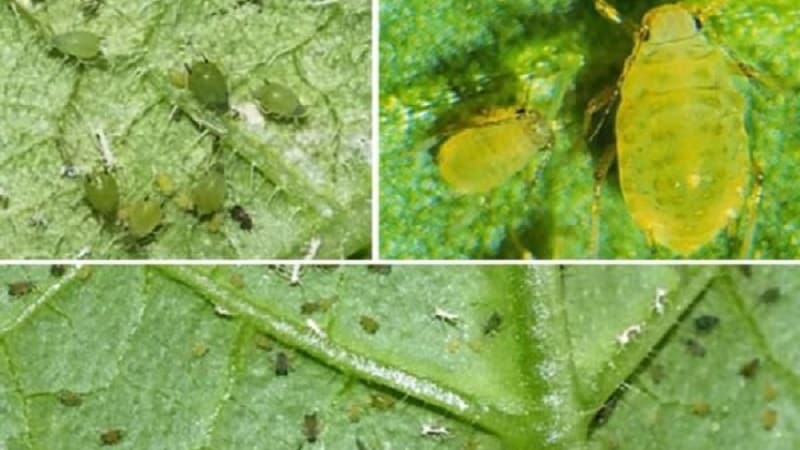
What kind of aphid infects cucumbers?
The main pest of cucumbers is the melon or cotton aphid.. This is a small insect, body length is 1-2 mm. Some individuals reach 5 mm. The species contains winged and wingless forms. The body color is different, ranging from light yellow to rich green, almost black. Each individual has a proboscis with which it pierces the surface of leaves and shoots.
The development of melon aphids begins in the spring, when eggs laid on a host plant in the fall hatch into a larva. The larva feeds on the sap of the plant, and after molting it begins to reproduce. During the summer, one female reproduces more than 10 times; more than 500 individuals of winged and wingless forms can appear from her. In autumn, winged females fly to a weed plant, where they begin laying eggs for the winter.
Interesting. Insects lead a sedentary lifestyle, but move quite quickly. Winged individuals can travel long distances and create colonies in new places.
How to understand that cucumbers are affected by aphids
At the initial stage, it is not easy to determine whether a plant is infested with aphids.. However, pests multiply quickly and in a short time, if plant protection measures are not taken, they completely cover the ovaries, flowers, and young shoots, destroying part of the seedlings.
To preserve the harvest and prevent the proliferation and spread of aphids, it is necessary to regularly inspect the plantings for the presence of pests.
It can be useful:
Why boric acid is useful for cucumbers and how to use it
Why do you need to treat cucumbers with brilliant green and how to do it
You can determine that cucumbers are affected by melon aphids by external signs:
- leaf curling;
- the appearance of yellow spots on the leaves, their complete or partial yellowing;
- massive leaf fall;
- slowing down plant growth;
- sticky drops on leaves and stems;
- the presence of an anthill nearby or ants scurrying along the stems;
- accumulation of small parasites on the spread of curled leaves.
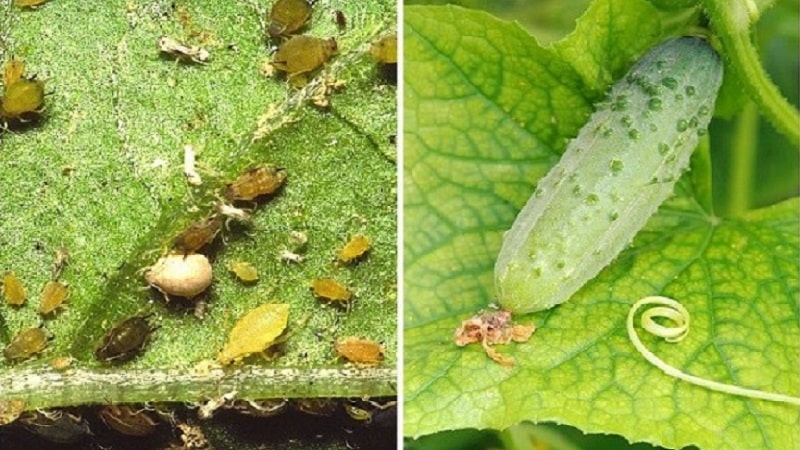
Causes of defeat
The appearance of aphids on cucumbers may be due to favorable climatic conditions in the region (air temperature +22-23 °C, humidity at 80%), non-compliance with the planting density of cucumbers, the presence of weeds where parasites lay overwintering eggs.
Another reason for the appearance of aphids on cucumbers is ants.. They contribute to the spread of pests, as they feed on their sweet liquid secretions and protect colonies of pests from insect predators. For the winter, they hide the aphids from the cold in an anthill, and in the spring, with the onset of warmth, they transfer them to the plant.
Aphids on cucumbers: how to fight them
Plant protection should be carried out throughout the growing season. It is important not only to limit the activity of pests, but to provide for the time when aphids appear on cucumbers and prevent their reproduction and spread.
For this use different methods of fighting: direct destruction of parasites and indirect effects through environmental factors. When choosing the optimal method, take into account the area and degree of aphid infestation of cucumbers.
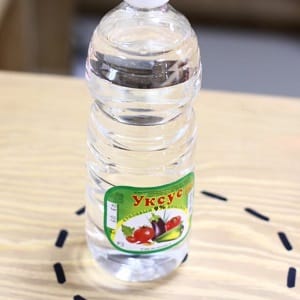 Important ways to protect cucumbers from aphids include:
Important ways to protect cucumbers from aphids include:
- Biological method. To suppress and reduce the number of parasites, predatory mites, parasitic insects, birds, and mammals are used.This also includes spraying plants with microbiological preparations.
- Chemical method. Involves the use of pesticides that are toxic to aphids on cucumbers. This method has a number of disadvantages: soil contamination, accumulation of pesticides in fruits, and the subsequent emergence of forms of agricultural pests that are resistant to toxins. In addition, after spraying, the fruits will be suitable for consumption in 15-30 days.
- Folk remedies. To treat foliage against cotton aphids, use an infusion of dandelion, celandine, pepper, onion peels, garlic, a mixture of laundry soap and wood ash, and vinegar. Irrigation is carried out regularly, every two to three days, until the insects completely disappear.
You should not plant other melons and melons next to cucumbers.: zucchini, squash. These plants can also be affected by aphids.
The effectiveness of vinegar against aphids
Table vinegar is used to prevent the appearance melon aphidon cucumbers and directly to eliminate the pest.
A solution of acetic acid has a distinct, specific odor that repels harmful organisms. Vinegar has a detrimental effect on aphids that have already settled on the plant and completely destroys the insect. The result of treatment with vinegar is in no way inferior to chemical agents.
Read also:
Feeding cucumbers with whey: the benefits of fermented milk product
How to properly use vinegar in pest control
Treating cucumbers with vinegar against aphids suggests several options.: spraying and watering. Irrigation is carried out using a special spraying device or spray bottle.
The solution is sprayed onto each leaf; it is especially important to treat it on the outside, where aphids usually settle. For large areas of damage, one procedure is not enough. Spraying is carried out every 2-3 days until the pests are completely eliminated. Then it is treated once every 3-4 weeks as a preventive measure.
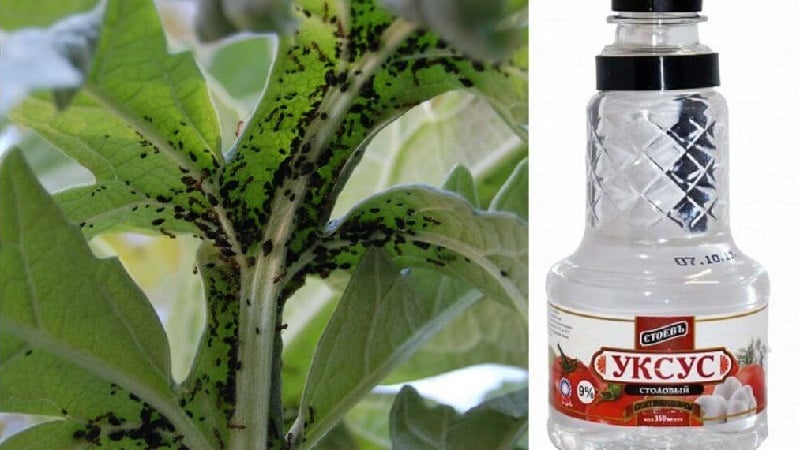
Vinegar solution recipe
The standard recipe is 1 tbsp. l. vinegar 9% per 1 liter of water. To increase efficiency, add 2 tbsp dish detergent to the solution. l. for 5 liters of water or laundry soap (tar or green soap is possible) at the rate of 2 tbsp. l. for 1 liter of water.
Soap improves the adhesion of foliage to the liquid solution, which lasts longer on the plant and, accordingly, is able to destroy more parasites. The prepared solution is used to treat the plantings.
You can use apple cider vinegar or vinegar essence as the main substance. It is more concentrated, so 2-4 tbsp will be enough for a 10 liter bucket. l. vinegar 70%.
Prevention
It is easier to prevent the appearance of melon aphids on cucumbers than to fight them. The following preventive measures help protect plantings from insect damage::
- competent and regular watering;
- maintaining the planting density of cucumbers;
- weeding, clearing weeds;
- tillage, application of fertilizers to agricultural crops during their growing season;
- choosing a cucumber variety that is resistant to pests and diseases;
- periodically watering the beds with a simple solution of laundry soap;
- autumn digging of the soil;
- planting plants with a pronounced smell near cucumbers to repel aphids: mint, mustard, basil, coriander, onion, garlic.
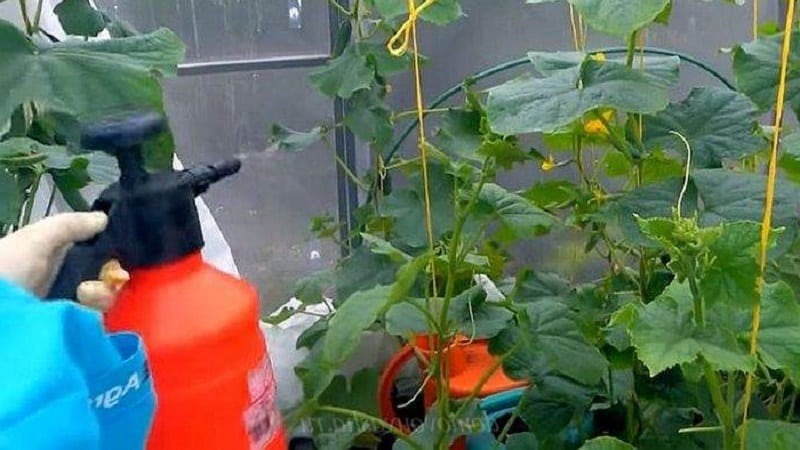
Prevention of aphid damage to cucumbers also includes measures against garden ants. Use chemical insecticides or folk remedies. The same vinegar will help: a solution of 400 ml of vinegar and the same amount of shampoo and vegetable oil. Dissolve the ingredients in 10 liters of water and stir.
Make a hole in the central part of the anthill, fill it with solution, and cover with cling film for several days.
Advice. The natural enemy of aphids is the ladybug. To protect cucumbers from pests with the help of beetles, mustard leaves are planted next to the plant.
Conclusion
It is necessary to carry out measures aimed at combating pests of agricultural crops in a timely and correct manner, without harm to the fruits and the human body.
Vinegar against aphids on cucumbers is an affordable, simple and effective treatment method. The acidic liquid can be used as a preventive measure. Positive reviews from gardeners confirm the effectiveness of the folk remedy.